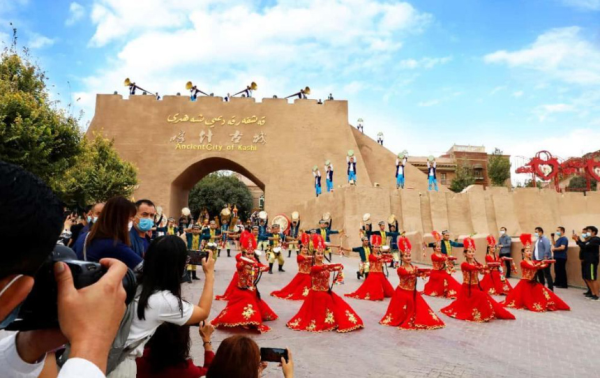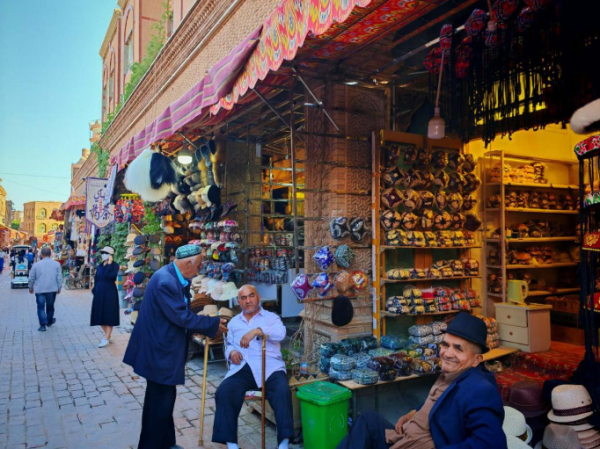KPL
Located in the southwestern part of Xinjiang Uygur autonomous region, Kashgar sits on a lush oasis nourished by the Yarkant River, which flows from the Karakoram Mountains.

The ancient city of Kashgar. Photo by Yumit Qadir
By Che Bin, Li Yanan, People's Daily
(KPL) Located in the southwestern part of Xinjiang Uygur autonomous region, Kashgar sits on a lush oasis nourished by the Yarkant River, which flows from the Karakoram Mountains.
Since ancient times, traders and travelers crossing the Pamir Plateau have stopped here to rest, trade, and connect. This made Kashgar a key hub along the ancient Silk Road and one of Xinjiang's earliest international trading posts. Historical figures such as Zhang Qian, Xuanzang, Faxian, and Marco Polo all left their footprints in this storied land.
Today, Kashgar stands as China's gateway to the west, an international corridor leading to Central, West, and South Asia, and the starting point of the China-Pakistan Economic Corridor. Departing from downtown Kashgar and heading south along the Karakoram Highway, known as the "China-Pakistan Friendship Road," one can reach Taxkorgan Tajik autonomous county after a 300-kilometer drive.
Just north of Taxkorgan lies the Ruins of Stone City, a site with more than 2,000 years of history. When Buddhist monk Xuanzang in Tang Dynasty (618-907) returned from his journey to India, he passed through the site and later described the ancient stronghold in his travelogue "The Great Tang Records on the Western Regions." Weathered by time, the ruins still stands with quiet grandeur.

Performers dance outside the ancient city of Kashgar to welcome tourists. (Photo by Wang Zhenqiang)
In downtown Kashgar lies the ancient city of Kashgar, which dates back over 2,100 years. Known as a "living city of antiquity," it begins each day with a ceremonial opening: at sunrise, dancers emerge from its streets, greeting visitors with cheerful music and vibrant performances.
Wandering through the ancient city, one encounters 99 alleys that twist and turn, lined with earth-toned buildings decorated with flower pots, intricate wood carvings, colorful domes, and overhanging eaves. As families expand, new generations add floors to their homes, creating a unique and compact architectural landscape with hanging houses and enclosed passageways. Over time, more than 20,000 residences have formed a dense, labyrinthine urban layout - one of the largest inhabited clusters of earthen buildings in the world.
In the early Yuan Dynasty (1271-1368), Italian traveler Marco Polo described Kashgar in his travel notes as a city with beautiful gardens, orchards, vineyards, and merchants from every corner of the world.
In August last year, Italian hiking enthusiast Vienna Cammarota visited Kashgar. Before her trip to China, she had read about the city in The Travels of Marco Polo. Upon arrival, she was thrilled to discover that Kashgar was not only a vital hub on the ancient Silk Road but also a place brimming with vitality today.

Photo shows a street in the ancient city of Kashgar. (Photo by Che Bin/People's Daily)
"The streets are lively by day and poetic at night," she said. "There's a constant hum of voices and the air is filled with the aromas of spices, freshly baked bread, and sizzling barbecue."
In the ancient city of Kashgar, there is a cafe named Dili & Diya, run by a young local man, Dilxat Tursun, and his Tanzanian wife Hadiya.
Hadiya attributed her opportunity to live and study in China to the Belt and Road Initiative. She met Dilxat Tursun while both were students in Fuzhou, southeast China's Fujian province. In May 2020, the couple returned to Dilxat Tursun's hometown Kashgar.
"The moment I arrived in Kashgar, I fell in love with it," Hadiya said. "The city has a rich history, and the people are warm and hospitable. In my hometown of Zanzibar, there's also a Stone City, which feels quite similar to Kashgar. That connection made me feel even closer to this place."
Their cafe features hand-crafted pottery cups from Kashgar and wall decorations from Africa. "Tanzanian coffee beans are well-known in the Chinese market," said Dilxat Tursun. "So in March 2023, we opened this cafe together. Hadiya taught me how to grind beans and brew rich, flavorful coffee. Our lattes are made with local milk and Tanzanian coffee beans, a fusion that reflects the East-meets-West charm of Kashgar ancient city."
"With China's visa-free policy expanding its coverage, we're seeing more and more international visitors at our cafe," he added.
As the business grows, securing a steady supply of coffee beans has become a top priority. "When we first started, we would bring beans back with us during family visits to Tanzania. Now, they're shipped via a more stable route - from Africa to Europe, then to Kashgar by China-Europe freight trains," he explained.
At the end of last year, construction began on the China–Kyrgyzstan–Uzbekistan Railway. Dilxat Tursun was among the first to celebrate the news. "This railway starts in Kashgar. We hope for its swift completion and operation, which would make coffee bean transport even easier. More importantly, I believe this project will open up more trade opportunities and improve daily life for people in the countries along the route," he said.
KPL